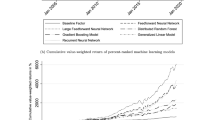Abstract
We examine the role of extreme positive returns in the cross-section of stock returns in seven countries. While Bali et al. (J Financ Econ 99:427–446, 2011) find a significantly negative relation between the maximum daily returns over the past month (MAX) and the expected returns in the following month, we find that this relation disappears and even often reverses. The positive relation is found in Canada, the UK and the US, while the pattern in China is more in line with the previous findings, and for Germany, France and Japan the effect is not statistically significant. Further evidence using the US data suggests that the positive effect of MAX is largely a proxy for the idiosyncratic volatility. Moreover, we find that the MAX effect is mainly concentrated on periods before 1990’s given the same dataset as Bali et al. (2011). Collectively, our results indicate that the MAX effect is not stable over time. We conjecture the changing proportion of MAX-seeking investors is a crucial determinant of the MAX-return relation.


Similar content being viewed by others
Notes
Reported in The Economist (May 31, 2011). Liquidity and lottery tickets—Why investors overpay for certain assets.
The main analysis in Bali et al. (2011) was based on a sample from 1962 to 2005, although they also had robustness tests with data starting in 1926.
In the original paper, their results show that inclusion of MAX variable reverses the anomalous negative relation between idiosyncratic volatility and returns in Ang et al. (2006).
References
Amihud Y (2002) Illiquidity and stock returns: cross-section and time-series effects. J Financ Mark 5:31–56
An L, Wang H, Wang J, Yu J (2015) Lottery-related anamolies: the role of reference-dependent preferences. Working paper
Ang A, Hodrick RJ, Xing Y, Zhang X (2006) The cross-section of volatility and expected returns. J Finance 61:259–299
Ang A, Hodrick RJ, Xing Y, Zhang X (2009) High idiosyncratic volatility and low returns: international and further U.S. evidence. J Financ Econ 91:1–23
Annaert J, Ceuster MD, Verstegen K (2013) Are extreme returns priced in the stock market? European evidence. J Bank Finance 37:3401–3411
Baker M, Wurgler J (2006) Investor sentiment and the cross-section of stock returns. J Finance 61:1645–1680
Bali TG, Cakici N, Whitelaw RF (2011) Maxing out: stocks as lotteries and the cross-section of expected returns. J Financ Econ 99:427–446
Banz RW (1961) The relation between return and market value of common stocks. J Financ Econ 9:3–18
Barberis N, Huang M (2001) Mental accounting, loss aversion and individual stock returns. J Finance 56:1247–1292
Barberis N, Huang M (2008) Stocks as lotteries: the implications of probability weighting for security prices. Am Econ Rev 98:2066–2100
Brunnermeier M, Gollier C, Parker J (2007) Optimal beliefs, asset prices and the preference for skewed returns. Am Econ Rev 97:159–165
Campbell JY, Lettau M, Malkiel BG, Xu Y (2001) Have individual stocks become more volatile? An empirical exploration of idiosyncratic risk. J Finance 56:1–43
Cheon Y-H, Lee K-H (2018) Maxing out globally: individualism, investor attention, and the cross section of expected stock returns. Manag Sci 64:5807–5831
Fama E, MacBeth J (1973) Risk, return and equilibrium: empirical tests. J Polit Econ 71:607–636
Fama EF, French KR (1992) The cross section of expected returns. J Finance 46:427–465
Fama EF, French KR (1993) Common risk factors in the returns on stocks and bonds. J Financ Econ 33:3–56
Fama EF, French KR (2015) A five-factor asset pricing model. J Financ Econ 116:1–22
Fong WM, Toh B (2014) Investor sentiment and the max effect. J Bank Finance 46:190–201
Fu F (2009) Idiosyncratic risk and the cross-section of expected stock returns. J Financ Econ 91:24–37
Goetzmann WN, Kumar A (2007) Why do individual investors hold under-diversified portfolios. Working paper
Han B, Kumar A (2008) Retail clienteles and the idiosyncratic volatility puzzle. Unpublished working paper
Han B, Kumar A (2013) Speculative retail trading and asset prices. J Financ Quant Anal 48:377–404
Harvey CR, Siddique A (2000) Conditional skewness in asset pricing tests. J Finance 55:1263–1295
Hausch D, Lo V, Ziemba WT (1994) Efficiency of racetrack betting markets. Academic Press, San Diego
Hur J, Singh V (2017) Cross section of expected returns and extreme returns: the role of investor attention and risk preferences. Financ Manag 46:409–431
Jiang X, Lee B-S (2006) The dynamic relation between returns and idiosyncratic volatility. Financ Manag 35:43–65
Kumar A (2009) Who gambles in the stock market? J Finance 64:1889–1933
Levy H (1978) Equilibrium in an imperfect market: a constraint on the number of securities in the portfolio. Am Econ Rev 68:643–658
Lo A, Mackinlay A (1990) Data-snooping biaes in tests of financial asset pricing models. Rev Financ Stud 3:431–468
Malkiel B, Xu Y (2002) Idiosyncratic risk and security returns. Working paper
Merton R (1987) A simple model of capital market equilibrium with incomplete information. J Finance 42:483–510
Mitton T, Vorkink K (2007) Equilibrium underdiversification and the preference for skewness. Rev Financ Stud 20:1255–1288
Nartea GV, Kong D, Wu J (2017) Do extreme returns matter in emerging markets? Evidence from the Chineses stock market. J Bank Finance 76:189–197
Newey W, West K (1987) A simple, positive semi-definite, heteroskedasticity and autocorrelation consistent covariance matrix. Econometrica 55:703–708
Odean T (1999) Do investors trade too much? Am Econ Rev 89:1279–1298
Tversky A, Kahneman D (1992) Advance in prospect theory: cumulative representation of uncertianty. J Risk Uncertain 5:297–323
Walkshäusl C (2014) The max effect: European evidence. J Bank Finance 42:1–10
Zhong A, Gray P (2016) The max effect: an exploration of risk and mispricing explanations. J Bank Finance 65:76–90
Author information
Authors and Affiliations
Corresponding author
Additional information
Publisher's Note
Springer Nature remains neutral with regard to jurisdictional claims in published maps and institutional affiliations.
Rights and permissions
About this article
Cite this article
Yuan, S., Rieger, M.O. & Caliskan, N. Maxing out: the puzzling influence of past maximum returns on future asset prices in a cross-country analysis. Manag Rev Q 70, 567–589 (2020). https://doi.org/10.1007/s11301-019-00176-3
Received:
Accepted:
Published:
Issue Date:
DOI: https://doi.org/10.1007/s11301-019-00176-3




